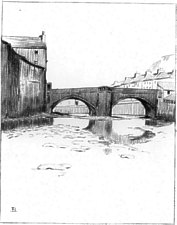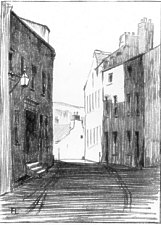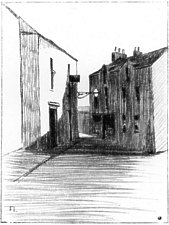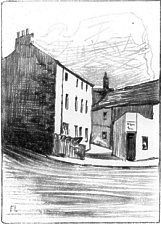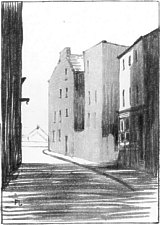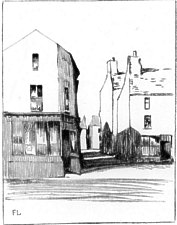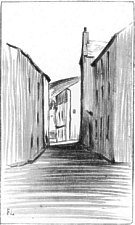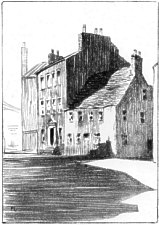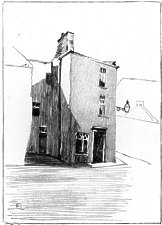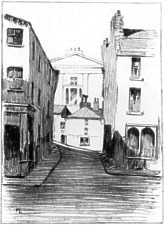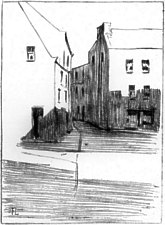DOUGLAS BRIDGE
A drawing of the old stone bridge made from the river looking towards the harbour, the buildings on the right above the bridge are the South Quay houses. The bridge was built about 1813 by, I understand, public subscription.
WOODHOUSE TERRACE
On the South Quay. The building on the right, only partly seen in the drawing with a fine hand-rail, on the steps, was the residence of Holmes the banker and next door was the bank. The building at the top of the courtyard shown complete was occupied by a Mr. Kelly who was Holmes' clerk. There was a passage-way inside the house leading into the bank and it was Mr Holmes' custom before retiring to go into the bank to see that everything was in order.
St. BARNABAS SQUARE
A view looking towards Seneschall Lane. The building on the left was at one time occupied by Mr. Quirk, who was a former High-Bailiff. The date of the building is 1789 and this in a general way may be taken as the date of most of the buildings hereabout.
FORT STREET
The building on the left is known as Redfern's Wesleyan Mission, and is almost opposite the entrance to Barnabas' Square
LEWTHWAITE'S COURT, FORT STREET
A very interesting corner. It is composed of three houses set at an angle with Fort Street almost opposite the site of the old hospital now a coalyard. The road on the opposite side was known as Lewthwaite's slip.
FORT STREET, THE FORT
The square building on the right in the centre of the drawing is locally known as the Fort, though why it is so called is difficult to know. Certainly it has nothing to do with the old fort as this was situated much nearer the sea on a site about the base of the Victoria Pier. Personally I think it has derived its name from the unusual squareness of the design. The building on the left is the bonded stores of H.M. Customs.
BOND LANE
Looking up from the North Quay. The building on the left was once occupied by a Mr Welsh , a furrier, his nickname, "The Birdcatcher," showing that he also dealt in birds. It is said that the top of the building, of wood, was added by him as a place to keep pigeons and other birds. Rabbits were consigned to him from all over the Island and were brought to Douglas by the coaches which put up as a rule on the Quay between the Coffee Palace and the Royal Hotel.
BOND LANE
From New Bond Street looking down Bond Lane towards the Quay. At the bottom is the side-view of Welch the Furrier's shop the view of which from the quay is the subject of another drawing. In the distance is Douglas Head and the quarry above the flight of steps leading to the Head.
HANOVER STREET
A very interesting corner. The smaller house has long been unoccupied and is falling into decay. The red brick house adjoining must at one time have been one of the finest in Douglas. It contained much fine woodwork which, since it became a tenement house, I am afraid has become firewood. There is a tradition that Bishop Murray (1823) lived here. He was a nephew of the Duke of Athol and was the last appointment made by him before selling all his rights in the Island to the English Government.
OLD HOUSE, HANOVER ST.
Now in a very dilapidated condition was for a long time kept as a toffee shop. It is next door to the old house in another sketch., the gable of which is shown.
CHURCH STREET
A view looking up Church Street from behind the Town Hall. The building in the centre is the Court House and immediately below it on the left is a small house re-built by a rather eccentric man "Happy Quirk." There is a tablet on the wall to this effect.
NELSON STREET
The corner of Nelson Street and Drumgold Street looking towards Cattle Market Street. The building on the left was formerly a public house kept by a Mr Freelis and the shop on the corner of Drumgold Street was known as "Clucas the Grocer's".
